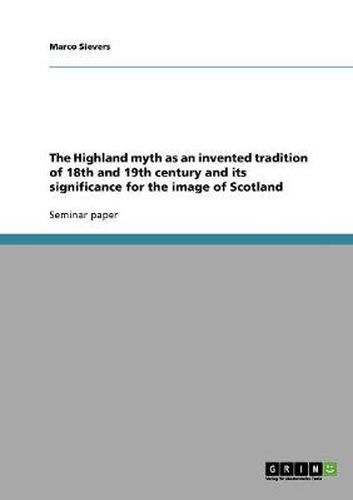Readings Newsletter
Become a Readings Member to make your shopping experience even easier.
Sign in or sign up for free!
You’re not far away from qualifying for FREE standard shipping within Australia
You’ve qualified for FREE standard shipping within Australia
The cart is loading…






Seminar paper from the year 2005 in the subject English Language and Literature Studies - Culture and Applied Geography, grade: 2, University of Hannover, course: Peripheries in British 19th-Century History: Scotland and Ireland, 12 entries in the bibliography, language: English, abstract: If people around the globe are asked what they associate with Scotland or the Scots, tartan kilts, bagpipes, clans and the Highlands are the most common answers. Especially tourist interest concentrates on these landmarks of Scotland, which are said to be insignias of Scottish tradition, glory and identity, and which dominate the image of Scotland. But are these landmarks really linked to a tradition from times immemorial? Do they really represent a link to Scotland’s Gaelic roots? This paper will investigate this question by introducing Eric Hobsbawms term of invented tradition to denote and to outline the process of creation of these Scottish symbols. The following portrait of the historical background will show the social, political and economic developments in the 18th and 19th century which led to the invention of tradition as part of the creation of a Highland myth as a result of and as reaction to Scotland’s union with England in 1707. Furthermore, the worldwide spreading of the Highland myth, which has determined the image of whole Scotland ever since, will be described. The paper will finish by showing contemporary parallels to the historic developments and trends, and suggesting further topics of investigation.
$9.00 standard shipping within Australia
FREE standard shipping within Australia for orders over $100.00
Express & International shipping calculated at checkout
Stock availability can be subject to change without notice. We recommend calling the shop or contacting our online team to check availability of low stock items. Please see our Shopping Online page for more details.
Seminar paper from the year 2005 in the subject English Language and Literature Studies - Culture and Applied Geography, grade: 2, University of Hannover, course: Peripheries in British 19th-Century History: Scotland and Ireland, 12 entries in the bibliography, language: English, abstract: If people around the globe are asked what they associate with Scotland or the Scots, tartan kilts, bagpipes, clans and the Highlands are the most common answers. Especially tourist interest concentrates on these landmarks of Scotland, which are said to be insignias of Scottish tradition, glory and identity, and which dominate the image of Scotland. But are these landmarks really linked to a tradition from times immemorial? Do they really represent a link to Scotland’s Gaelic roots? This paper will investigate this question by introducing Eric Hobsbawms term of invented tradition to denote and to outline the process of creation of these Scottish symbols. The following portrait of the historical background will show the social, political and economic developments in the 18th and 19th century which led to the invention of tradition as part of the creation of a Highland myth as a result of and as reaction to Scotland’s union with England in 1707. Furthermore, the worldwide spreading of the Highland myth, which has determined the image of whole Scotland ever since, will be described. The paper will finish by showing contemporary parallels to the historic developments and trends, and suggesting further topics of investigation.